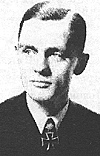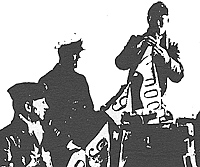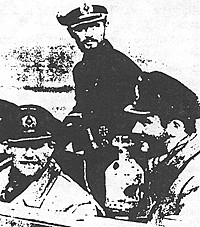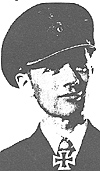 Did you know CAPT HARDEGEN did NOT volunteer for the U-Boats? Did you know that his heart was in the air? Even so, he became one of the most successful submarine Skippers of WW II; sank the first ship in U.S. waters; won the KNIGHTS CROSS and was one of only 28 U-Boaters to win the OAK LEAF CLUSTER.
Did you know CAPT HARDEGEN did NOT volunteer for the U-Boats? Did you know that his heart was in the air? Even so, he became one of the most successful submarine Skippers of WW II; sank the first ship in U.S. waters; won the KNIGHTS CROSS and was one of only 28 U-Boaters to win the OAK LEAF CLUSTER.
In battle, he was known as a fire eater. But he was a decent Skipper, once putting his boat into shallow waters between shore (Jacksonville Fl) and his target (the tanker GULFAMERICA) so any over-shots from his deck gun would go out to sea and not hit the cars and houses on the shore.
“I entered the Navy in 1933 and in 1935, I came to the Naval Air Force where I spent four years, through the Polish War. In November 1939, I was ordered into submarines. The reason for this being that as a German officer, I have already volunteered - so in being directed elsewhere, a German officer has no other recourse but to obey his new orders.
On 12 January (1942) we were off New York Harbor, and I thought that it would be a big surprise for the Americans that a submarine would be there. But it wasn’t because what I didn’t know then was that the British had broken the German Navy cypher (TRITON), then plotted my position every day and then had given that position to Admiral Ernest J. King - who did nothing!”
HARRY’S NOTE - the Brits had the code; they knew where each of the ‘DRUMBEAT’ U-Boats were each day and they gave this information to the US - but nothing was done by the Roosevelt Administration to head off the boats or to take any protective steps along the US east coast at all. Why this was done; why these ships were allowed to lumber into the waiting arms of the waiting German U-Boats is an ongoing subject of research today.
“There was no blackout or dimming of the lights. All lights were fully on, on both the light ships and regular shipping. Also, on Coney Island I could easily see both individual houses and cars. It was very easy.
 At right: U-123 returning to Lorient
At right: U-123 returning to Lorient
I waited off the Ambrose light ship as ships came out of the inner harbor of New York. The first night (13 January, 1942) I torpedoed and sank the (Panamanian registered) tanker NORNESS 40 miles west of the Nantucket light ship. At first she radioed that she had hit a mine, but I sent another torpedo to fulfill my business. NORNESS then transmitted that it was a submarine.
The next day, I sank the British tanker COIMBRA. All of this in the area of New York Harbor.
WATCHING THE DANCERS?
But in the United States, newspapers said that I was so near New York that I could see Manhattan, and see the people dancing on the roof of the Waldorf Astoria - which was nonsense! It was just a story because I didn’t pass the narrows and was not in the upper bay. Besides, even if I were, I could never have seen the people dancing on the roof of the Waldorf Astoria.
 At right: TONNAGE PENNANTS or ‘BRAGGING FLAGS’ READY FOR HOISTING BY U-123 ON HER RETURN FROM OPERATION ‘PAUKENSCHLAG” in U. S. WATERS. U-123 was "sunk" nearly every day.
At right: TONNAGE PENNANTS or ‘BRAGGING FLAGS’ READY FOR HOISTING BY U-123 ON HER RETURN FROM OPERATION ‘PAUKENSCHLAG” in U. S. WATERS. U-123 was "sunk" nearly every day.
“I then went southward, and the Americans sank me nearly every day. We heard the radio broadcasts. They said that ‘A German submarine sank a tanker, but our air force sank the submarine’.
“Then the next day, the same thing, which we were just laughing because there were some airplanes which did drop some bombs, but they were so far off. So three times I learned from the radio that I had been sunk. Always the same submarine, because in Operation ‘DRUMBEAT’ we had only 5 submarines sent over, and only one was off New York, and that was U-123, my boat.
Then we went south along the coast to Cape Hatteras, where I sank other ships on this patrol. Also, when my torpedoes were out, I sank ships with artillery.
 Photo at right: is HARDEGEN (center) with his two Watch Officers, Rudolf Hoffmann on the left and Horst von Schroeter on the right. This is the photo used by MIKE WOOTEN (232-1987) to do PRINT “D” ‘THE DRUMBEATER IS HOME’ which is hand-signed by all three officers and available from SHARKHUNTERS.
Photo at right: is HARDEGEN (center) with his two Watch Officers, Rudolf Hoffmann on the left and Horst von Schroeter on the right. This is the photo used by MIKE WOOTEN (232-1987) to do PRINT “D” ‘THE DRUMBEATER IS HOME’ which is hand-signed by all three officers and available from SHARKHUNTERS.
“On the next patrol, I started at Cape Hatteras, went down to Key West and sank one more ship.
But some of these ships were sunk in shallow waters, and their masts and funnels showed above the surface. So they were refloated and repaired, then sunk again by another submarine.”
In answer to a question whether CAPTAIN HARDEGEN ever had a really frightening moment, he answered
“That was off St. Augustine (10 April, 1942). I was in shallow water and a destroyer (USS DAHLGREN DD-187) dropped five depth charges. I was aground in about 23 meters (about 85 feet!). We wanted to abandon the ship, but when the destroyer passed over, it did not drop any more depth charges because he thought that he had sunk the submarine. He had made the failure of not waiting until the Captain’s WHITE CAP was floating on the sea.
We lost fuel and air pressure, and our deck planks were damaged. Some of the oil bubbles floated away, and that was what the destroyer saw and thought that we were sunk. It was a very difficult thing!
 When I was finished with the patrol, I sent a radio message of my success:”
When I was finished with the patrol, I sent a radio message of my success:”
- Sieben Tankern schlug,
die letzte Stund.
Die U-Falle sank Träger.
Zwei Frachter liegen mit auf Grung
Versenkt vom Paukenschlager
Translation:
- For seven tankers the hour has passed.
The Q-Ship went down by the meter.
Two freighters too, were sunk at last.
All of them by the same Drumbeater.
“This was the end of my second patrol to the United States. At the end of the war, I was commander of an infantry battalion, fighting south of Bremen. Then in the last days, I was in the headquarters of Dönitz in Flensburg.
When he received the OAK LEAF CLUSTER to his KNIGHTS CROSS
“If you look backwards to 45 years, you can see that we had to work very hard after the war because, as in my own case, I had nothing. No profession. I learned only to be an officer in the Navy. Now, I had a wife and four children who said "we are freezing, and we want something to eat, and something to clothe ourselves."
So I had to work very hard to bring all of these things. But we were successful because in Germany, after 1945, all people had to work hard so we had success, which is a very difficult thing today. After reunification, all of the people in the new countries, in the east, thought that they could get the same thing in two weeks that we made in forty years. That’s impossible! But I hope we will succeed to manage out this problem.
This year, I made a cruise in the Northwest Passage. On board was a man who was an Able Seaman on the American tanker MALAY. It was outbound on 19 January, 1942, in ballast, from Philadelphia for Port Arthur, Texas. I torpedoed this tanker and attacked also with guns. I thought that she sank, because she transmitted a message that she needed help quickly, because she was sinking. But they were able to put her aground and later salvage and repair her.
So after fifty years, I met this man on a cruise ship in the Northwest Passage. Enemies of yesterday are friends today.”
It was CAPTAIN HARDEGEN who gave us our SHARKHUNTERS motto, which says YESTERDAY’S ENEMIES ARE TODAY’S FRIENDS. You see it on every issue of our KTB Magazine.
Thanks to CAPTAIN HARDEGEN for making this tape, which is available to Members with the interview with OTTO KRETSCHMER (122-LIFE-1985) and CAPT. HELMUT SCHMOEKEL (1455-C-1990). You may order TAPE A-19 which costs only $15 (plus $5 shipping)
Thanks to STEVE for this interview, and thanks to HELEN FARRELL (1133-1989) for transcribing from the tape.
PRINT D as described in this story, is also available to Members. This great print is from an original by MIKE WOOTEN (232-1987). Check the advertising flier in this issue of our KTB Magazine.
Back to KTB #118 Table of Contents
Back to KTB List of Issues
Back to MagWeb Master Magazine List
© Copyright 1996 by Harry Cooper, Sharkhunters International, Inc.
This article appears in MagWeb (Magazine Web) on the Internet World Wide Web. Other military history articles articles are available at http://www.magweb.com
Join Sharkhunters International, Inc.: PO Box 1539, Hernando, FL 34442, ph: 352-637-2917, fax: 352-637-6289, www.sharkhunters.com
